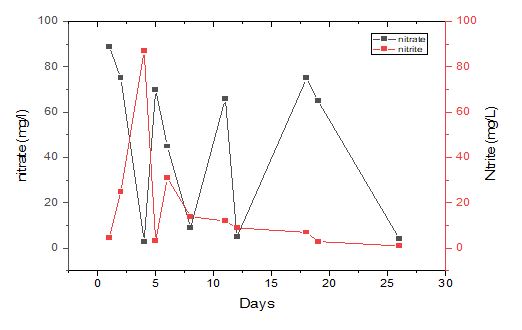Heterotrophic Denitrification Of Wastewater By Using Melanoidin As Sole Carbon Source
Keywords:
Heterotrophic, Denitrification, Master Culture Reactor, ToxificationAbstract
Removing nitrate effects through heterotrophic denitrification is an effective approach to treating water or wastewater containing these contaminants. The effective management of wastewater is of paramount importance to mitigate its adverse impacts on both human health and the environment. This study delves into the biodegradation and removal of nitrate and nitrite by introducing melanoidin as a carbon source, the research explores the influence of batch test strategy using a heterotrophic denitrification process for removal of toxicity by using inoculum from MCR (master culture reactor) for 48 hours in which four controls (C1, C2, C3, C4) and five test sample of different dilutions of melanoidin i.e. 100 ppm, 250 ppm, 500ppm, 700 ppm and 1000 ppm were used. The results demonstrate that remarkable removal of nitrate, nitrite, and TOC was found in 100 ppm, 250 ppm and 500 ppm dilutions, with a marked reduction of Total organic carbon (TOC), indicating successful toxicity removal, 750 ppm and 1000 ppm dilutions were not affected by denitrification in TOC removal. Subsequent denitrification of the T1, T2, and T3 samples showcases the potent synergy between treatment processes. Through the use of a C:N ratio of 2:1 and 3:1, 98.14% of nitrate was successfully removed within 48 hours. High-Performance Ion Chromatography (HPIC) was employed to analyze the samples treated with denitrification, revealing the complete elimination of toxicity. These results highlight the crucial role of melanoidin as a carbon source in denitrification, enabling thorough nitrate degradation and detoxification. This study underscores the importance of adopting innovative treatment methods to address the growing challenges associated with wastewater management.
References
Sociol Health Illn.
AZZIZ, G., ILLARZE, G. & IRISARRI, P. 2016. Heterotrophic Denitrification and Paracoccus spp. as Tools for Bioremediation. In: CASTRO-SOWINSKI, S. (ed.) Microbial Models: From Environmental to Industrial Sustainability. Singapore: Springer Singapore.
CHEN, H., YE, Q., WANG, X., SHENG, J., YU, X., ZHAO, S., ZOU, X., ZHANG, W. & XUE, G. 2024. Applying sludge hydrolysate as a carbon source for biological denitrification after composition optimization via red soil filtration. Water research, 249, 120909.
FANG, F., YANG, J., CHEN, L.-L., XU, R.-Z., LUO, J.-Y., NI, B.-J. & CAO, J.-S. 2024. Mixotrophic denitrification of waste activated sludge fermentation liquid as an alternative carbon source for nitrogen removal: Reducing N2O emissions and costs. Journal of Environmental Management, 362, 121348.
FERNÁNDEZ-NAVA, Y., MARANON, E., SOONS, J. & CASTRILLÓN, L. 2008. Denitrification of wastewater containing high nitrate and calcium concentrations. Bioresource Technology, 99, 7976-7981.
FU, X., HOU, R., YANG, P., QIAN, S., FENG, Z., CHEN, Z., WANG, F., YUAN, R., CHEN, H. & ZHOU, B. 2022. Application of external carbon source in heterotrophic denitrification of domestic sewage: A review. Science of The Total Environment, 817, 153061.
GONSALEZ, V. L., DOMBROWSKI, P. M., LEE, M. D. & RAMSBURG, C. A. 2023. The Influence of pH on Subsurface Denitrification Stimulated with Emulsified Vegetable Oil. Water, 15, 883.
MAHMOUD, A., HAMZA, R. A. & ELBESHBISHY, E. 2022. Enhancement of denitrification efficiency using municipal and industrial waste fermentation liquids as external carbon sources. Science of The Total Environment, 816, 151578.
PAINTER, S. C., ARTIOLI, Y., AMIR, F. H., ARNULL, J., GANESHRAM, R. S., IBRAHIM, N., SAMUEL, V. D., ROBIN, R., RAGHURAMAN, R. & PURVAJA, R. 2023. Anthropogenic nitrogen pollution threats and challenges to the health of South Asian coral reefs. Frontiers in Marine Science, 10, 1187804.
PANT, D. & ADHOLEYA, A. 2007. Biological approaches for treatment of distillery wastewater: A review. Bioresource Technology, 98, 2321-2334.
QAMBRANI, N. A., JUNG, S. H., OK, Y. S., KIM, Y. S. & OH, S.-E. 2013. Nitrate-contaminated groundwater remediation by combined autotrophic and heterotrophic denitrification for sulfate and pH control: batch tests. Environmental Science and Pollution Research, 20, 9084-9091.
SCHROEDER, A., SOUZA, D. H., FERNANDES, M., RODRIGUES, E. B., TREVISAN, V. & SKORONSKI, E. 2020. Application of glycerol as carbon source for continuous drinking water denitrification using microorganism from natural biomass. Journal of Environmental Management, 256, 109964.
SINGH, N. & SANTAL, A. 2013. Biodegradation of Melanoidin from Distillery Effluent: Role of Microbes and Their Potential Enzymes.
WANG, H., CHEN, N., FENG, C. & DENG, Y. 2021. Insights into heterotrophic denitrification diversity in wastewater treatment systems: Progress and future prospects based on different carbon sources. Science of The Total Environment, 780, 146521.
ZOU, Y., XU, X., WANG, X., YANG, F. & ZHANG, S. 2018. Achieving efficient nitrogen removal and nutrient recovery from wastewater in a combining simultaneous partial nitrification, anammox and denitrification (SNAD) process with a photobioreactor (PBR) for biomass production and generated dissolved oxygen (DO) recycling. Bioresource Technology, 268, 539-548.

Downloads
Published
How to Cite
Issue
Section
License
Copyright (c) 2024 50SEA

This work is licensed under a Creative Commons Attribution 4.0 International License.




















